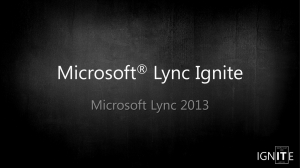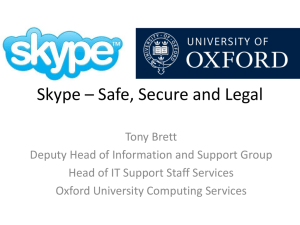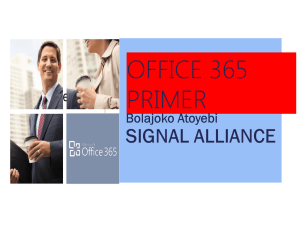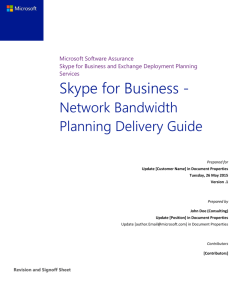The new visual identity - Competition Law Association
advertisement
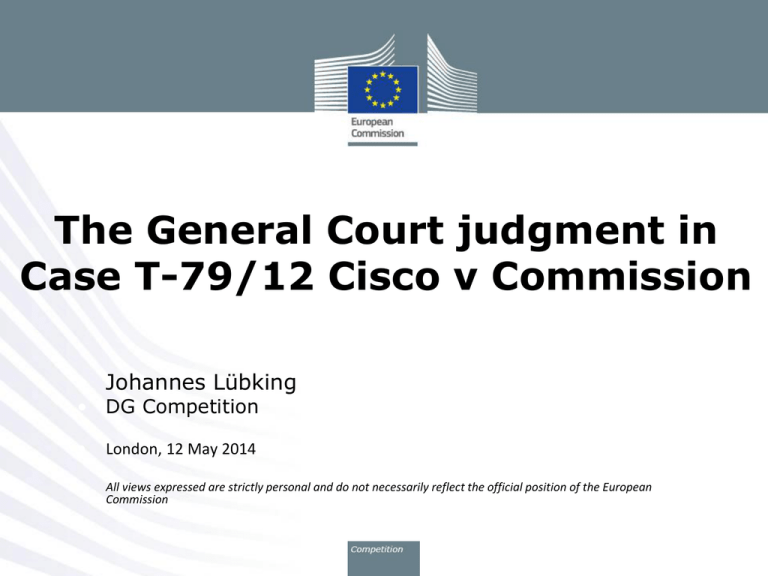
The General Court judgment in Case T-79/12 Cisco v Commission • Johannes Lübking • DG Competition • London, 12 May 2014 • All views expressed are strictly personal and do not necessarily reflect the official position of the European Commission Introduction • Rejection of the appeal brought by Cisco and Messagenet against the 2011 Commission decision clearing the acquisition of Skype by Microsoft in Phase I without conditions • Important policy messages for Phase I clearance decisions in merger cases regarding: • mergers in new markets and technologies • the standard of proof and reasoning of decisions 2 The Microsoft/Skype decision • The parties • Microsoft: – Leading/dominant in PC operating systems ("Windows") – Provides communication services for consumers ("Windows Live Messanger") and enterprises ("Lync") • Skype: market leader for video calls for consumers • Horizontal assessment: • Consumer communication services – Market definition left open » Possible segmentation by functionalities/platform/operating system – Shares high in certain segments (especially video calls on Windows-based PCs), but volatile and numerous competitors with strong brands – Nascent and dynamic sector, services offered free of charge – Competitive contraints from other platforms (tablets, smartphones…) • Enterprise communications: Skype not seen as a market player 3 The Microsoft/Skype decision (cont'd) • Conglomerate assessment • Possible concerns: – Degradation of Microsoft and Skype products with third parties – Bundling of Microsoft products with Skype products • But: limited impact on consumers – Microsoft has limited presence in Skype’s market – Skype already closed system – Communication software depends on network effects – Alternatives to Skype on web available • Outcome: Phase I clearance without remedies 4 The judgment: General remarks • The Court: • carries out a thorough analysis of the arguments raised by the plaintiffs • based on general principles of the effects of mergers on competition: • High market shares may indicate market power unless counterveiled by other factors • Conglomerate effects cannot be presumed but must be based on specific indications and a plausible theory of harm • within a the context of an adversarial procedure: • Arguments/facts brought forward by the plaintiffs can be dismissed by uncontested statements in the Commission decision 5 The judgment: horizontal overlap in market for consumer video communications • Presumption of dominance in case of market shares of 50% or more only if a relevant market has been defined • Narrowest segment considered: consumer video communications on Windows-based PCs • Precise product market definition left open by Commission 6 The judgment: horizontal overlap (cont'd) • High shares in specific segments of emerging technology markets are less indicative of market power • In particular with volatile market shares and presence of strong competitors • Market for consumer video communication: – Presence of strong competitors – Increasing use of mobile phones and tablets, where Microsoft was a relatively small player • High combined 80-90% share no indication for market power • Short innovation cycles • Competitive pressure from players using tablets, smartphones, Facebook • Network effects no additional advantage to merged entity • Policy by Microsoft of making users of PCs pay would make them switch to other providers of free products 7 The judgment: conglomerate effects • Plaintiffs challenged Commission assessment of conglomerate effects in the enterprise communications market • Microsoft would be able and have the incentive to reserve to its product Lync preferential interoperability with Skype (including its large user base) • The Court: • Lync faces competition from other large players on enterprise communications market (e.g. Cisco) • Thus a strategy of limiting interoperability would not be profitable • Applicants' claim rejected that the Commission had not given sufficient reasons for conglomerate assessment • Very succinct discussion of the conglomerate aspects of the case … • … but: context of the decision, need for speed in merger cases, far-fetched theory of harm brought forward by complainants • No need to discuss arguments clearly not relevant for the decision 8 The judgment: Standard of proof in Phase I/ Phase II • The plaintiffs: • "Serious doubts" test means that standard of proof for a clearance in Phase I is higher than in Phase II • The Court: • Same assessment criteria and standard of proof in Phase I and II: balance of probabilities ("more likely than not") • Whether the Commission is able to clear a merger in Phase I or Phase II "only depends on the period in which the evidence becomes available but does not alter the standard of that evidence" 9 Some conclusions • The Commission can clear a merger in phase I if balance of probabilities for absence of competition concerns – opening of phase II depends on when evidence becomes available • Important clarification of standard for third-party appeals against Phase I merger decisions (following precendents in Sun Chemical, Spar) • How to respond to complaints? • Need for speed: no need to discuss every possible aspect • But: The Commission must respond to arguments brought forward by complainants unless clearly irrelevant • Plausibility test regarding theory of harm • Overall message: The requirements regarding standard of proof and reasoning of Phase I merger clearance decisions should not be exaggerated 10



